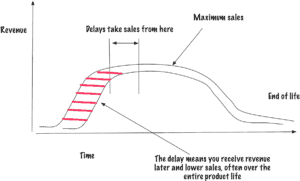 As I said in my Day 1 post, my WIP is too high. Here's where I stand with my WIP:
As I said in my Day 1 post, my WIP is too high. Here's where I stand with my WIP:
- I completed one presentation, so I have 4 remaining
- I have some feedback on the book that I need to integrate. I want to address the next 3 chapters, because they're the platform for the next part of the book.
- I finished one week of the videos for the writing workshop.
- I wrote zero fiction words.
- I wrote zero column words.
In addition, I also have a new task: get one book ready for another distributor. (If you're wondering, I self-publish my books these days. Yes, I have a checklist that I use as my “done” criteria. This specific distributor recently changed their checklist, so I need to change mine.)
I bet I'm not the only one who realizes they have “new” work after they thought they knew “everything” they had to do that week.
How do I decide what to do? Cost of Delay for ease.
How Cost of Delay Makes My Decisions Easier
These are the two items that I can assign a specific Cost of Delay to:
- Get the book ready for the distributor because this will add to my company's revenue.
- Finish another week of videos for the writing workshop because I want to announce it “soon.” In fact, the sooner I announce it, the sooner I can make money.
The other items on my list will eventually make me money, but not as immediately as these two.
And the writing workshop will make more money sooner than the book will. While this distributor reports monthly income, they only pay once a quarter.
My cost of delay means that my first job is to finish the video editing for the writing workshop. (I use Screenflow to take my Zoom videos and edit them. Then export to the final videos for consumption.)
If I want, during my exporting, I might start the work for the book distributor. I don't need a lot of brainpower to do that work.
Cycle Time Makes My Decisions Easier
My cycle times for my various work:
- About an hour to complete the videos for workshop week. I have 5 weeks remaining, so I will need about 5 hours. Some weeks will take more time, some less. But I can use an hour as my cycle time for each week of videos.
- The four presentations range in duration from 15 to 90 minutes. (The 90 minutes is a workshop.) My normal cycle time for presentations is roughly three times the duration of the presentation.
- I expect the book distributor work to take roughly an hour.
Since I know my cycle time and I know the various Costs of Delay, here's what I think I can finish today:
- Complete the writing workshop video editing.
- Complete the book distributor work.
Here's my (currently) ordered list I can pull from, once I finish that:
- The shortest presentation
- The book, because my fingers are itching to finish it. Also the novella. Also the columns. I would rather be writing. Hehehe.
Notice that I don't need to know precisely how much time I need for any of my work. I don't need to know. I use right-sizing to manage my interim deliverables to achieve the final outcome.
Make Your Work Easier
I needed to write down my Cost of Delay reasoning above to make better decisions. (If you work with a team, have a verbal discussion. As with most interesting problems, the discussion matters more than any numbers, because that drives your reasoning and decisions.) Before I wrote that down, I thought I would finish the book distributor work first. But no, that's not the most valuable work, even if it's the shortest work.
That's why Shortest Job First does not always work as a ranking approach. But Cost of Delay always works to rank any of your work.
Your team can learn exactly what I do:
- Right-size the work and create smaller valuable deliverables on the way to the final outcome.
- Learn the cycle time for most of your types of deliverables.
- Use Cost of Delay to rank the work.
- Plan just enough to deliver.
- As you deliver one item, ask yourself if you need to replan.
- When you finish the planned work, use your backlog/list to pull from. (Assuming you still have time in your workday.)
This is an agile way of working that does not require a lot planning and preparation. It does require you have an overarching goal, to know why you're doing this work.
The series:
- How I Manage My Product Development: Ease with Continuous Flow (Day 1)
- How Cycle Time and Cost of Delay Makes Product Development Decisions Easier (Day 2)
- Easier Product Development Decisions and Why Backlogs Might Slow You Down (Day 3)
- Focus on One Internal Deliverable Allows Me to Work Down My WIP (Day 4)
Hi Johanna, thanks for the concise description of your workflow process. I notice one issue, where you state “I wrote zero column words”. You did write this ‘day 2’ column. You confused me.
Next to that, can you please make links for the articles in the series-list at the bottom?
Keep on writing as I love your blogs.
Thanks and regards, Ronald
Hi Ronald, Thanks for this comment. I will either explain or fix this in today’s posts. And add the links! I was excited about getting to the work :-).
I finally added the series links to each post, including today’s! Thanks for the nudge.
Thanks Johanna